Vanessa Van Edwards is a communications expert. In her book Cues, she discusses the language of human social cues as well as what it takes to be charismatic. She has grouped cues into the four basic kinds of communication: Nonverbal, Vocal, Verbal, and Imagery. How cues affect and shape your ability to communicate effectively with coworkers, clients, friends, and family. Vanessa also offers practical tips on how to improve interpersonal communication and leadership, as well as her thoughts on how we communicate. She’s created a science-based project and provided a framework for recognizing diverse personalities in order to improve our EQ and communicate properly.
Book Title: Cues: Mastering the Secret Language of Charismatic Communication, Small Signals, Incredible Impact.
Author: Vanessa Van Edwards
Date of reading: June 2022
Rating: 8/10
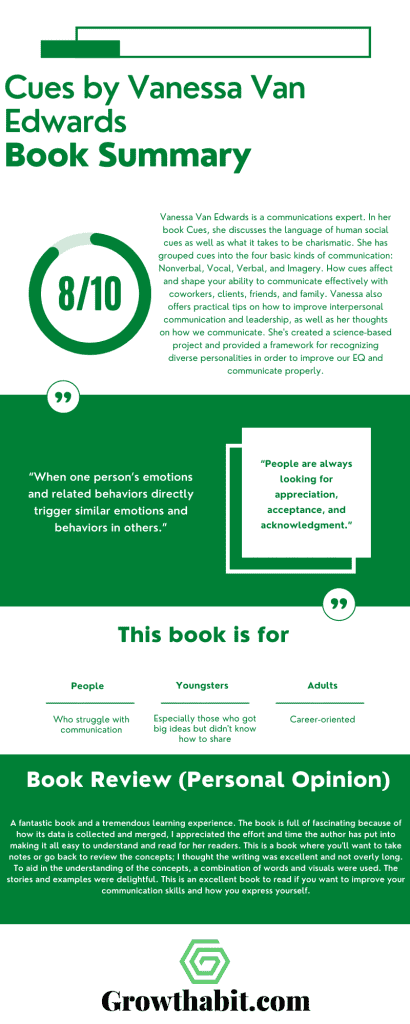
What Is Being Said in Detail
This book introduces us to the art of effective communication and provides us with the practical information we need as we travel the world and meet new people in various situations. It emphasizes the significance of minor things. What small cues can we embrace to make a difference and transform our lives?
The book is organized into two parts and ten chapters by the author. The first two chapters explain an introduction and the Importance of cues. The author then goes on to explain the various sorts of nonverbal cues in the next four chapters before integrating vocal, verbal, and imagery cues in the final four chapters.
Part one explains and emphasizes the underestimated power of nonverbal cues, which is four hundred times more impactful than verbal cues. It includes the body language and the wow factor of a charismatic person. It also has the ability to spot a bad guy and not be the one when it comes to nonverbal cues.
Part two explains the power of sound, vocal likability, imagery, and powerful visual presence. How to communicate with the right balance.
The Secrets that are Secretly Shaping You
The introduction explains the importance of non-verbal cues and what to look forward to in the Vocal Cues section, how to make your emails, chats, and profiles more impactful in the Verbal Cues section, and why Imagery Cues are more important than we might think.
Cues for Charisma
Chapter 1 defines the true essence of charisma that people immediately recognize in you and explains the simple formula required to achieve it. The balance of warmth and competence
How Cues Work
Chapter 2 teaches the technique of decoding, encoding, and internalization, the perfect cue cycle, and enlightens the fact that your cues can be contagious.
Part One – Nonverbal Cues
The Body Language of a Leader
Chapter 3 provides insight into the power of nonverbal cues to influence and highlights five charisma cues to engage more purposefully.
The Wow Factor
Chapter 4 explains how and where warm cues work and can be replaced with warm words. Highlight six warmth cues: eyebrow raise, nodding, head tilting, leaning, forward, touch, and mirror.
How to Look Powerful
Chapter 5 expands the cue chart by exploring six power cues to create a powerful presence and how to get people’s attention and make them understand just by explanatory gestures.
How to Spot a Bad Guy . . . and Not Be One Yourself
Chapter 6 discusses five danger cues: and how they can be avoided and used to our advantage. Additional insights into distancing, self-soothing, blocking, shame, and bothered face complete the nonverbal cues chart.
Part Two – Vocal, Verbal, and Imagery Cues
Vocal Cues
Sound Powerful
Chapter 7 analysis of the incredible power of vocal cues. It provides fun tips and an explanation of five vocal power cues.
Vocal Likability
Chapter 8 will give insights on five vocal warmth cues that make you likable and warm: Make a memorable vocal first impression; sound friendly; learn how to sound more interesting; sound encouraging and inviting; channel your charisma.
Verbal Cues
How to Communicate with Charisma
Chapter 9 teaches five steps to avoid sounding like a bore: Stop being boring, create charisma, be inspirational or informational, and be a verbal chameleon. The power of words is a wonderful cue.
Imagery Cues
Creating a Powerful Visual Presence
Chapter 10 shows the surprisingly mild effects that colors and visuals have on our environment. Give four visual cues that expand vision: Elevate your price, your looks, and your brand; images that inspire; your nonverbal brand; make me confident; and cues that bias.
Cues Best Practice
The conclusion summarizes the power of cues and highlights practices and rules to accommodate all the cues in day-to-day life. It provides four charts to track the progress and make each cue work for you.
Most Important Keywords, Sentences, Quotes:
INTRODUCTION – The Secrets that are Secretly Shaping You
“A strong idea cannot stand alone. It needs to be accompanied by strong cues.”
“[…] He focused too much on the content and not enough on the cues. Cues could have supported his message, but instead they undermined it.”
“When you uncover the cues being sent to you, everything becomes clearer. You won’t miss hidden emotions. You know who and what information to trust. You can communicate authentically and assertively.”
“When you learn to send the right cues to others, people start listening to you, find you engaging, and are more interested in what you have to say.”
“You’ll also feel more confident going into your interactions. The right cues can take a lackluster conversation, meeting, or interaction and make it memorable. Send the wrong cues and potential opportunities are missed, doubted, and overlooked.”
“I have grouped cues into four different channels: Nonverbal, Vocal, Verbal, and Imagery. And this is how the book is organized.”
CHAPTER ONE – Cues for Charisma
“In a groundbreaking study from Princeton University, researchers found that highly charismatic, likable, compelling people demonstrate a special blend of two specific traits: warmth and competence. It’s a simple equation: Warmth Cues +Competence Cues =Charisma.”
“Highly charismatic people use both warmth and competence cues to communicate successfully. We love being around people who make us feel like we are in both safe and capable hands. We like our leaders to be both highly effective and very approachable. We look for partners we can trust with our deepest secrets and call in an emergency. We want to work with people who are both friendly and productive.”
“Your desire to be liked can get in the way of your need to be respected. You might be seen as:
- Trustworthy but not always powerful
- Compassionate but not always competent
- Friendly but not always impressive.”
“You’re likely higher in warmth if people tell you things like:
- I always feel so comfortable around you!
- You’re such a sweetheart.
- I feel like I have known you forever.
- You have a trustworthy face.”
“You’re likely higher in competence if people tell you things like:
- I never know what you’re thinking.
- You can be a little intimidating!
- You’re hard to read.
- You must be the one in charge here.”
“Researchers have found that if you rank low in both warmth and competence, you are more likely to be overlooked, dismissed, pitied, and undervalued.”
“You can have the best content in the world, but if it’s not shared with the right charisma cues, it doesn’t land.”
“If you can’t showcase your warmth, people won’t believe in your competence.”
“Yes, there is one formula to charisma—warmth cues plus competence cues. But each of us has our own special balance. As long as you’re in the Charisma Zone, you’re showcasing enough warmth and competence to be perceived as credible and trustworthy.”
“The most charismatic people move flexibly within the Charisma Zone.”
CHAPTER TWO – How Cues Work
“The palm-up cue is a signal of openness and trust. It’s a high warmth cue, best used when trying to get people to be more collaborative and open. When I get to the question-and-answer part of my presentations, I always use the palm up gesture to invite questions. The palm down cue is a signal of power and dominance. It is a high competence cue.”
“Cues give us the full picture behind this painting. Da Vinci’s masterful use of cues allowed him to tell a richer story in a single image. When you read cues, you see hidden meanings, understand more, and everything has more clarity.”
“You’ve certainly experienced these sensations before. They often come to us in the form of “intuition” or “gut feelings.” But what’s really happening is that your brain probably saw a cue from the Danger Zone of the Charisma Scale it didn’t like. This ability, this spidey sense, is our secret superpower. Learning to decode cues gives a name to your intuitive hits.”
“When one person’s emotions and related behaviors directly trigger similar emotions and behaviors in others.”
“Labeling negative cues reduces their impact. Learning cues will help you spot and stop negative cues being sent to you and be more in control of the cues you send to others.”
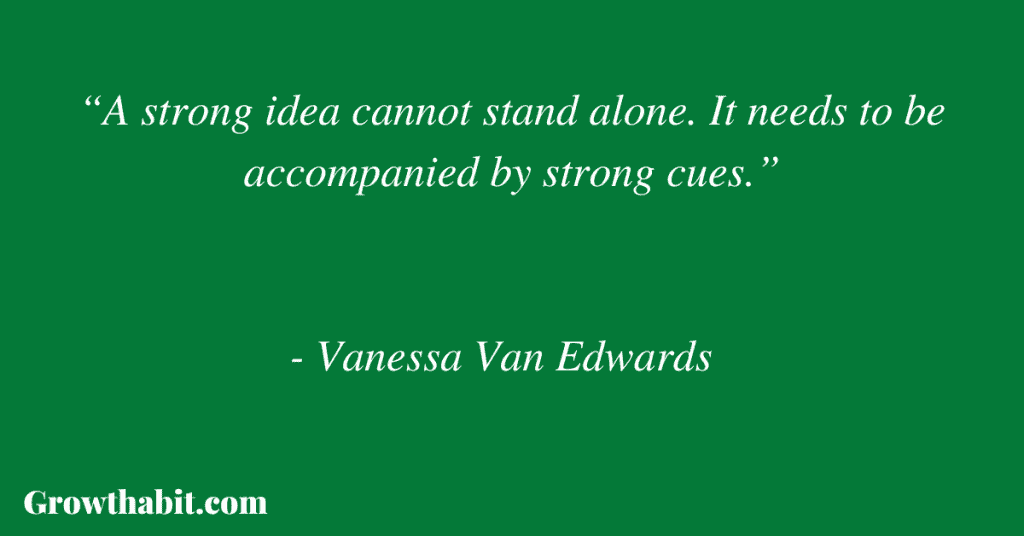
“Your cues can also help you influence for good and be positively contagious. Leaders can learn to spread productive feelings to others. When you project warmth, people are more likely to be warm with you. When you project a competent, confident calm, others are more likely to follow suit. Your charisma cues can flip others’ negative ones.”
“When most people think about communication, they think about decoding cues. Decoding is how we read and interpret social signals from others. Social signals help us decipher everything about a person—their intentions toward us, their trustworthiness, their competence, even their personality.”
“Encoding is how we send social cues. We send some cues purposefully—we stand with good posture to show confidence, or we smile to show friendliness. But many of our cues are accidental. We can’t control every cue we send—it’s almost impossible to alter your blink rate, for instance—but we can influence our most important cues.”
“Internalizing is how cues influence your internal emotional state—your productivity, your success, and your mood. The cues we decode in the world change how we feel about the world. Every cue we spot is internalized, which influences which cues we subsequently encode.”
CHAPTER THREE – The Body Language of a Leader
“People are always looking for appreciation, acceptance, and acknowledgment.”
“When most people think about communicating, they focus on one piece: verbal. While words matter, unfortunately, your words alone aren’t enough nonverbal cues influence—by either enhancing or detracting from how your words are understood. The old cliché is true: “You hear what you see.” ”
“One study found that people with strong nonverbal cue recognition earn more money in their jobs.”
“We use nonverbal cues to assess everything—capability, social skills, and hire ability. And nonverbal cues are either supporting your message or detracting from it.”
“Lean cues are powerfully charismatic nonverbal signals because they both communicate interest to others and trigger internal interest.”

“A closed body signals a closed mind . . . and it inspires closemindedness in others.”
“Nonverbal cues don’t just have an effect in situations where you are physically present. They also come across in your profile photos, websites, social media photos, and marketing materials.”
“Fronting is when you angle your body to signal attention. Specifically, we point our three T’s—toes, torso, and top—toward whatever we’re paying attention to. Our physical orientation cues others as to our mental orientation. Fronting is a great cue to know what someone is thinking about.”
“The biggest mistake we make while attempting to build connection is giving only partial nonverbal attention.”
“The closer we feel to someone, the closer we allow them to come physically.”
“Gaze is an attention cue. We look to gaze to see who or what someone is paying attention to.”
CHAPTER FOUR – The Wow Factor
“Warmth cues create loyalty. We are drawn to people who wow us. Warmth cues are also powerful because they create a halo effect. If you’re warm and trustworthy, it makes people feel more trust for everything about you—from your personality to your office to your service to your mannerisms . . . even to your accent.”
“Warmth cues create a wow factor for everything about you. They signal trustworthiness, engagement, inclusion—all the warm and fuzzy feelings that make us feel close to others. Using tilts, nods, eyebrow raises, savor smiles, touches, and mirroring creates a halo effect around you.”
“Warm listeners sparked the Cue Cycle, and inspired people to feel more wowed. Cold body language caused people to withhold their ideas, think small, and be more close-minded.”
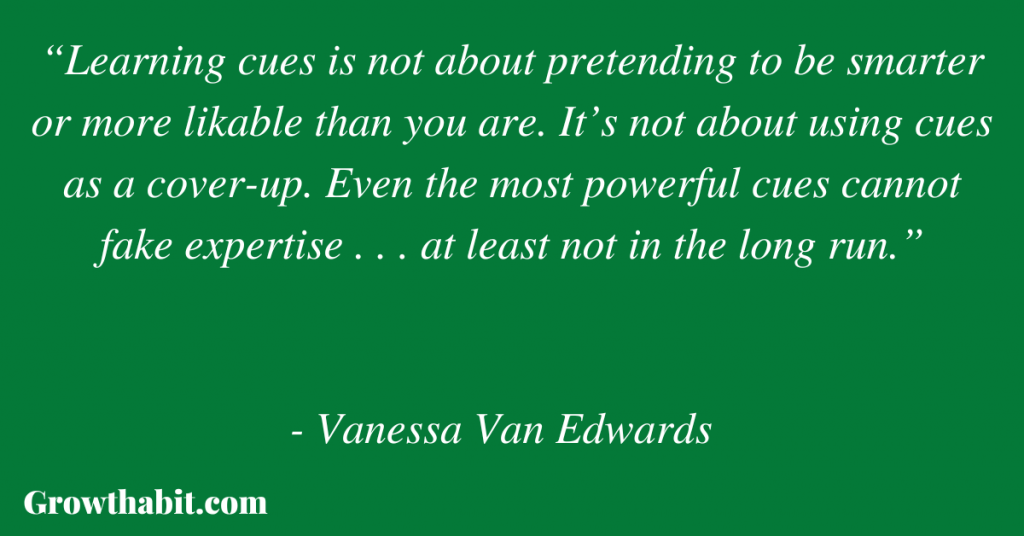
“Nodding is also one of the most underutilized persuasion tools. In the mid-nineties, attorneys began to notice that nodding was having an effect on their courtroom cases.”
“[…] smiling creates an internal and external wow. Smiling has internal benefits as well as social benefits.”
“Study after study shows that a subtle touch increases trust in all kinds of relationships, from social to romantic to professional.”
“Warning: Mirroring is so potent that only subtle mirroring is needed. Copy every cue and you will quickly stray into creepy territory. The key is to mirror subtly—no need to copy every gesture.”
CHAPTER FIVE – How to Look Powerful
“Expansive posture helps you both look and feel more powerful.”
“A sudden lid flex means someone has gone from just listening to scrutinizing. It’s a cue for you to pause.”
“Steepling is a powerful gesture to convince others of your commitment to and confidence in what you’re saying. It shows you’re relaxed and open and they should be too.”
“Powerful and confident people don’t waste energy on purposeless movement. They move with intention. They don’t hesitate. They don’t stall. They aren’t jerky. They know exactly what they want. People with clear thought take clear action.”

“Researchers found that purposeful, confident gestures improve comprehension by 60 percent. And some gestures are so powerful that they carry 400 percent more information!”
“The better you know your verbal content, the more easily you’re able to demonstrate it.”
“Explanatory gestures help you explain and others understand.”
“When you flash your palms, people pay attention. We’re hypersensitive to palm cues because we know the hands are our deadliest weapon. Researchers found that when we raise our palms, we activate our limbic system, specifically the amygdala, which is the defensive area of the brain. In other words, palm flashes cue our emotions.”
CHAPTER SIX – How to Spot a Bad Guy . . . and Not Be One Yourself
“Physical distancing can trigger emotional distance. The most charismatic people are stable, present, and engaged. They front, they lean in, they get closer. Distancing is the opposite of those positive cues.”
“Self-touch gestures negatively impact your charisma on two levels. First, comfort gestures make you look anxious. Study after study finds that comfort gestures, fidgets, and extraneous movements make you look less charismatic.”
“Our nonverbal cues are contagious. Your nervous gestures inspire nervousness.”
“Most important, don’t encode your own anxiety with accidental blocks. These cues will immediately drop you into the Danger Zone.”
“A furrowed brow makes us less happy, less agreeable, and less engaged overall.”
“You can use Danger Zone cues to subtly signal disapproval, dislike, or disengagement.”
CHAPTER SEVEN – Sound Powerful
“Understanding vocal cues is incredibly important for uncovering others’ feelings toward you, your work, and your projects.”
“If it feels unnatural using a deep pitch, it’s too low! There are two ways to keep it natural: space and breath.”
“Even the most confident words said with the question inflection invite less confidence. If you want people to take you seriously and believe in what you have to say, then tell people what you’re thinking, don’t ask them.”
“Vocal fry is not an indication that you are laid-back, it’s a signal of self-consciousness.”
CHAPTER EIGHT – Vocal Likability
“Never answer the phone in a bad mood—or while holding your breath.”
“Use words that cue for nonverbal warm.”
“Many professionals think emotion gets in the way of their message, but it actually enhances it.”
“Going emotionless doesn’t sound casual or cool; it sounds careless.
“Introverts in particular struggle with vocal variety because it calls attention to yourself. Here’s a reframe: You’ve worked hard to accumulate your knowledge, skills, and ideas. You’re not calling attention to yourself; you’re calling attention to your ideas.”
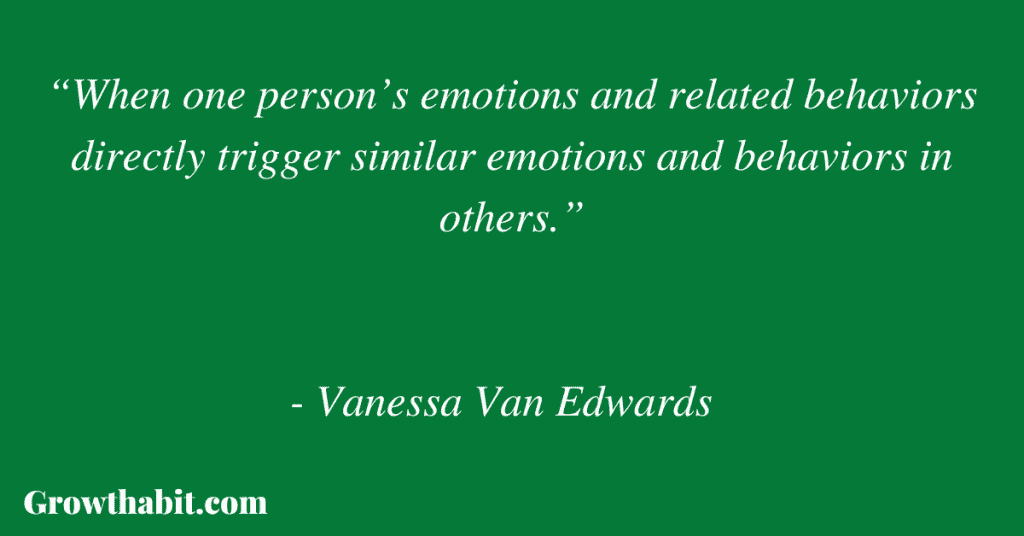
“The best way to use a nonverbal script is to help you remember where you need to add vocal variety, nonverbal emphasis, or helpful gestures.”
“We tend to overestimate how obvious our warmth, interest, and excitement is to others. Vocal invitations are one of the easiest low-barrier ways to signal.”
CHAPTER NINE – How to Communicate with Charisma
“If you want to project warmth, use more warm words. If competence is your goal, use more competent words.”
“Most people don’t use overly negative words, just boring ones.”
“Many people assume there is warmth in their boring, sterile emails, but connection should never be assumed.”
“When writing emails, imagine not just what you want your recipients to know but how you want them to feel.”
CHAPTER TEN – Creating a Powerful Visual Presence
“Keep in mind people are surprisingly sensitive to font and have lots of personal preferences.”
“The best way to leverage the power of visual cues is to use them as emphasizers.”
“Complex facial expressions elicited more views than smiling ones.”
“The key is to create a consistent cue language across your brand assets.”
“An unconscious bias is a social stereotype we carry about certain groups of people.”
CONCLUSION – Cues Best Practice
“Learning cues is not about pretending to be smarter or more likable than you are. It’s not about using cues as a cover-up. Even the most powerful cues cannot fake expertise . . . at least not in the long run.”
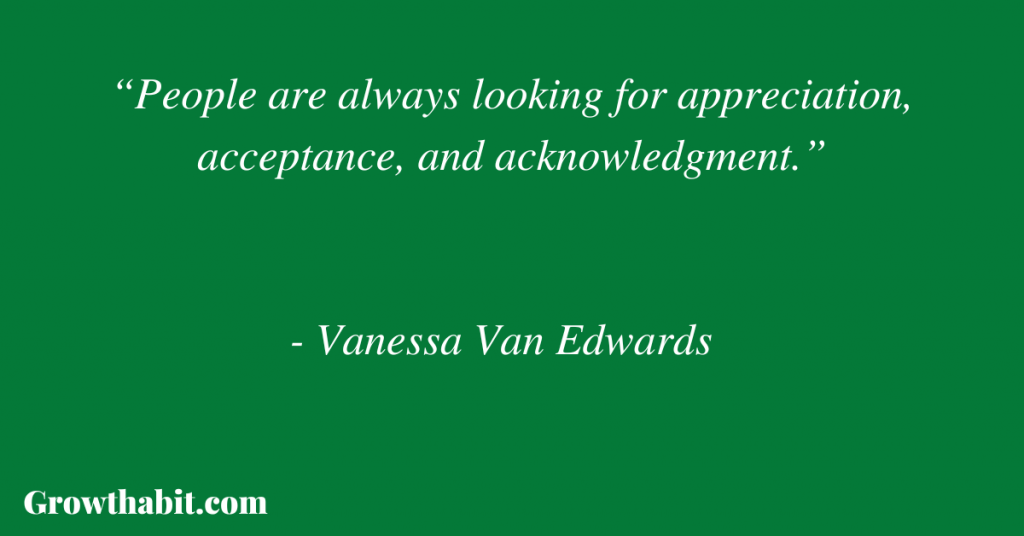
“Be sure to practice decoding and encoding each cue in a few scenarios with a few different people—at work, at home, with friends. Dial up your warmth and competence to always be in the sweet spot of the Charisma Zone.”
“Make every cue work for you. Modify them, adapt them, and add your own twists and flairs—although not a nose flare, which can be seen as aggressive.”
Book Review (Personal Opinion)
A fantastic book and a tremendous learning experience. The book is full of fascinating because of how its data is collected and merged, I appreciated the effort and time the author has put into making it all easy to understand and read for her readers. This is a book where you’ll want to take notes or go back to review the concepts; I thought the writing was excellent and not overly long. To aid in the understanding of the concepts, a combination of words and visuals were used. The stories and examples were delightful. This is an excellent book to read if you want to improve your communication skills and how you express yourself.
Rating: 8/10
This Book Is For:
- People who struggle with communication
- Youngsters (especially those who got big ideas but didn’t know how to share)
- Career-oriented adults
If You Want To Learn More
Here is the book’s author’s detailed and easy-to-understand summary. You’ll hear her discussing all of the cues she describes in the book.
Mastering The Secret Language Of Charismatic Communication
How I’ve Implemented The Ideas From The Book
The author has conducted extensive research into the subject of people and communication.
It turns out that CHARISMA is defined as the perfect combination of WARMTH and COMPETENCE.
Division of the cues into four sections: Nonverbal cues (which covers around half of the book), Vocal Cues (power of voice), Verbal cues (Communication skills), and Imagery cues (power of visuals) helps in understating their application a lot.
I had to take frequent breaks from reading in order to practice and internalize all of the new knowledge and insights. The way the author discussed when to use and when not to use each cue based on your unique goals and settings is quite enlightening and helpful.
Here is the list of the things I Have started to do after going through “Cues.”
- To feel and appear more confident, widen the gap between your ears and shoulders.
- Remove any physical impediments and turn your head, shoulders, and feet to face your speaking partner(s).
- To appear more knowledgeable, use the lower portion of your vocal range.
- Avoid inquiry inflections.
- Using hands more and showing palms and gestures to be more charismatic.
- Slow nod and lean forward to express warmth and engagement.
- In emails, have started to strike a good balance of warmth and competence cues.
One Small Actionable Step You Can Do
At the end of each chapter, there are a variety of fun challenges to help you practice your cues. They make the learning process go more smoothly. Complete each challenge and the cue charts located throughout the book. The author has included scientifically validated data charts that can be used to track progress.
